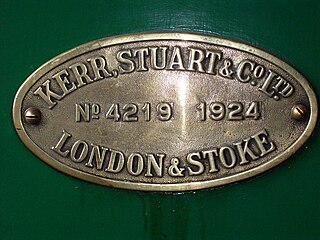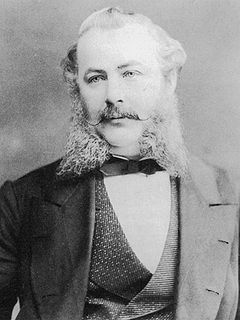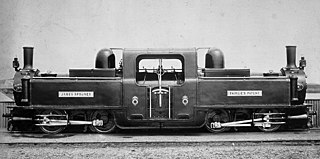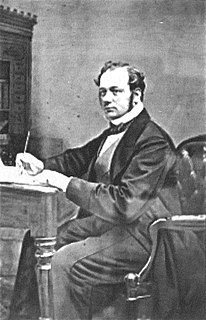
A Fairlie is a type of articulated steam locomotive that has the driving wheels on bogies. The locomotive may be double-ended or single ended. Fairlies are most famously associated with the Ffestiniog Railway in North Wales.

Sir Daniel Gooch, 1st Baronet was an English railway locomotive and transatlantic cable engineer. He was the first Superintendent of Locomotive Engines on the Great Western Railway from 1837 to 1864 and its chairman from 1865 until his death in 1889.

Darlington railway works, was established in 1863 by the Stockton and Darlington Railway in the town of Darlington in the north east of England. The main part of the works, the North Road Shops was located on the northeast side of the Stockton and Darlington Railway

Kerr, Stuart and Company Ltd was a locomotive manufacturer from Stoke-on-Trent, England.

Robert Francis Fairlie was a Scottish-born railway engineer.

The Spooners of Porthmadog refers to the Spooner family of Porthmadog, North Wales who made important contributions to the development of narrow gauge railways both locally and throughout the world. James Spooner, together with his sons James Swinton and Charles Easton and other members of their family, constructed and managed the Ffestiniog Railway for over fifty years. In North Wales they were involved in the promotion of numerous railway schemes including many quarry lines, the Talyllyn Railway, the Festiniog and Blaenau Railway, the North Wales Narrow Gauge Railways and the Carnarvonshire Railway. Through publications and overseas family commissions they influenced narrow gauge railway construction in Russia, America and throughout the British Empire.

George England and Co. was an early English manufacturer of steam locomotives founded by the engineer George England of Newcastle upon Tyne (1811–1878). The company operated from the Hatcham Iron Works in New Cross, Surrey, and began building locomotives in 1848.
R and W Hawthorn Ltd was a locomotive manufacturer in Newcastle upon Tyne, England, from 1817 until 1885.
The Avonside Engine Company was a locomotive manufacturer in Avon Street, St. Philip's, Bristol, England between 1864 and 1934. However the business originated with an earlier enterprise Henry Stothert and Company.

R. B. Longridge and Company was a steam locomotive works which was established in 1838 at Bedlington, Northumberland, England, by Michael Longridge (1785-1858). The firm was directed by Robert Bewick Longridge (1821-1914), who was Michael's fourth son. It was closely connected with the Bedlington Ironworks which had been bought between 1782 and 1788 by Thomas Longridge, and William Hawks. The Bedlington Ironworks had been building locomotives since about 1827, but R. B. Longridge and Company was a new and up-to-date locomotive factory.
William Bridges Adams was an English author, inventor and locomotive engineer. He is best known for his patented Adams axle – a successful radial axle design in use on railways in Britain until the end of steam traction in 1968 – and the railway fishplate. His writings, including English Pleasure Carriages (1837) and Roads and Rails (1862) covered all forms of land transport. Later he became a noted writer on political reform, under the pen name Junius Redivivus ; a reference to a political letter writer of the previous century.

Thomas Green & Son, Ltd. were engineers who manufactured a wide range of products at the Smithfield Foundry, Leeds, United Kingdom
Whessoe is a company based in Darlington and on Teesside in North East England. It was formerly a supplier of chemical, oil and nuclear plant and instrumentation, and today is a manufacturer of low temperature storage.
The Eastern and Midlands Railway was formed in 1881 by the amalgamation of several small railways in the Isle of Ely, Cambridgeshire, Lincolnshire and Norfolk, England, including the Yarmouth and North Norfolk Railway, the Lynn and Fakenham Railway and the Yarmouth Union Railway. Many of these lines were built by contractors Wilkinson and Jarvis. In 1893 the Eastern and Midlands Railway became part of the Midland and Great Northern Joint Railway.
Hazledine and Company was an ironworks in Bridgnorth, Shropshire, England. It was set up about 1792 by three brothers: John Hazledine (1760–1810), Robert Hazledine (1768–1837) and Thomas Hazledine (1771–1842). Sources differ about the partnership - Discover Shropshire claims that the partners were John Hazledine, William Hallen and John Wheeler.

The 1825 to 1863 Stockton and Darlington Railway (S&DR) was world's first public railway to use steam locomotives, its first line connected collieries near Shildon with Stockton-on-Tees and Darlington, and was officially opened on 27 September 1825. While coal waggons were hauled by steam locomotives from the start, passengers were carried in coaches drawn by horses until carriages hauled by steam locomotives were introduced in 1833.
Edward Borrows and Sons was founded in 1865 by Edward Borrows, formerly of James Cross and Company. It was located at Providence Works, Sutton, near St Helens, England. The company's business included iron and brass founding and repairs to small locomotive engines.
Crook and Dean of Little Bolton, England, was an engineering company established around 1821. The partners were John Crook and William Dean (c.1798-1840) who should not be confused with the better-known William Dean (1840-1905).

Thomas Evans Blackwell was an English civil engineer.











